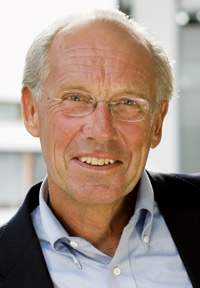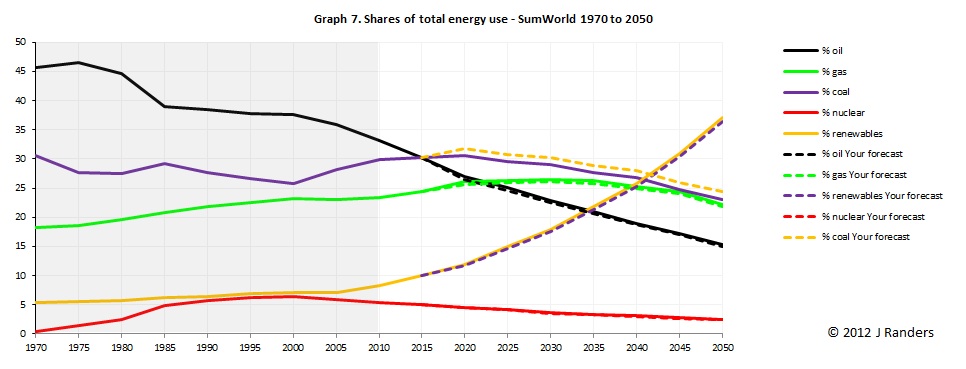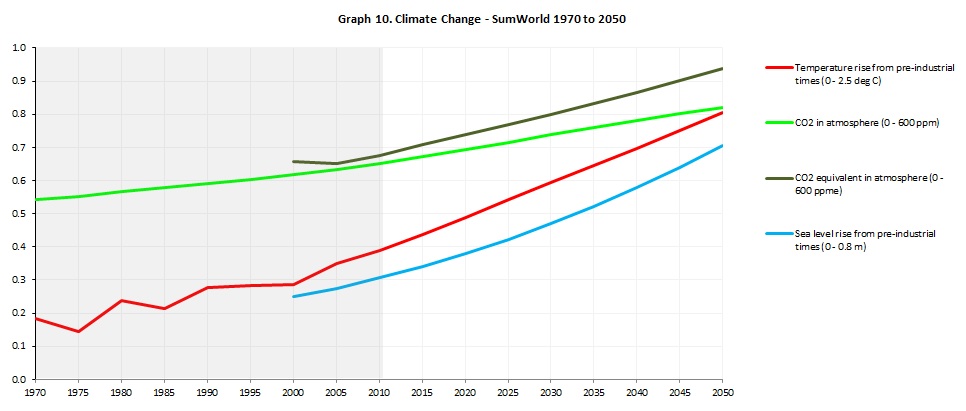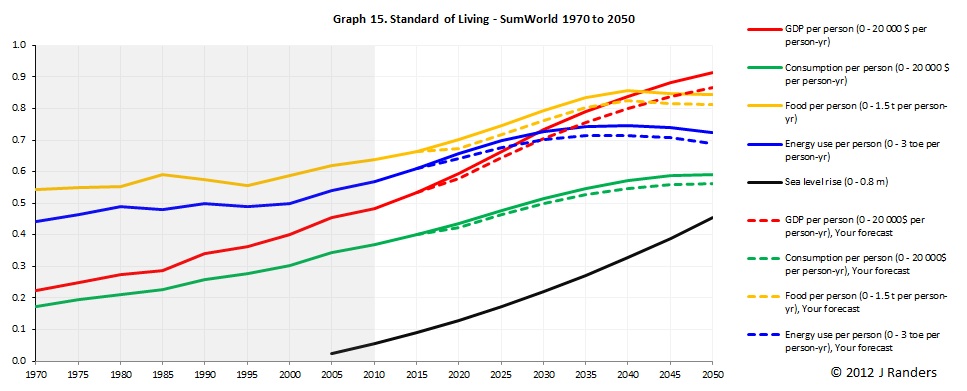File: c:/ddc/Angel/BestIntentions/Randers.html
Date: Tue Jul 24 13:38:50 2012
(C) OntoOO/ Dennis de Champeaux
Jorgen Randers
 Jorgen Randers contributed to the World3 system of which
Dennis Meadows was the lead, [Meadows]. Their World3 simulator was
developed around 1970 and ran from 1900 to 2100. He is also coauthor
of all the Limits to Growth (LTG) series of books that reported
on the many scenarios developed for collapse avoidance in the 21st
century. Randers became chronically worried because they did not get
traction with their work on plausible futures.
Finally, he couldn't take the uncertainty any longer and he decided to
make a new simulator using the actual developments during the 40 years
since 1970, [Randers]. His simulator is more modest and runs through
1970-2050. He claims repeatedly that his effort is made easy by the
inertia of the sociopolitical system: the preceding 40 years have
shown that humanity has persistently not been able to change its ways
to obtain better alternatives. Hence it stands to reason that
breakthroughs, while desired and certainly hoped for, will again not
occur. This could be a preventive move to counter those who claim
already for decades that human ingenuity will save the day.
Jorgen Randers contributed to the World3 system of which
Dennis Meadows was the lead, [Meadows]. Their World3 simulator was
developed around 1970 and ran from 1900 to 2100. He is also coauthor
of all the Limits to Growth (LTG) series of books that reported
on the many scenarios developed for collapse avoidance in the 21st
century. Randers became chronically worried because they did not get
traction with their work on plausible futures.
Finally, he couldn't take the uncertainty any longer and he decided to
make a new simulator using the actual developments during the 40 years
since 1970, [Randers]. His simulator is more modest and runs through
1970-2050. He claims repeatedly that his effort is made easy by the
inertia of the sociopolitical system: the preceding 40 years have
shown that humanity has persistently not been able to change its ways
to obtain better alternatives. Hence it stands to reason that
breakthroughs, while desired and certainly hoped for, will again not
occur. This could be a preventive move to counter those who claim
already for decades that human ingenuity will save the day.
... I basically believe that we will see the same rate of
technological and societal change over the next forty years as we have
seen over the last forty years.
His devil's advocate position is distinctly different from the LTG
books, in which collapse avoidance scenarios were patiently described
with the apparent expectation that the (world) leaders would use their
recommendations. Rander's tactic is formulated, very politely:
I know, I know that you are not able to do what you are supposed to
do, but let me tell you anyway one more time what unfortunate future
reality you therefore can expect.
His goal is limited in the sense that one can play less with
structural parameters (than is possible with the World3 model) to come
up with policy advice how to steer the world away from collapses.
Instead, the aim is to provide a most plausible scenario towards 2050
and a description of the situation in 2050.
The development of the 2052 system was driven by the desire to answer,
somewhat indirectly, the questions:
-- What will happen to consumption over the next forty years?
-- Under what conditions - in what social and natural environment -
will that future consumption take place?
While the World3 model is totally aggregated, the 2052 model has five
separate models for respectively: the US, the OECD minus the US,
China, BRISE (big emerging economies), and ROW (the rest of the world).
In addition, the five models are aggregated into a sixth World model.
Yet another major difference with World3 is that its generic pollution
module has been replaced (or complemented) with a climate module.
Noteworthy also is that the World3 non-renewable resources module has
been disaggregated with the components: oil, gas, coal, and nuclear.
Trends calculated (for the different regions and for the world) to
help answer these questions are, among others: the population size,
GDP per person, food per person, consumption per person, temperature
rise, sea-level rise, unused bio-capacity (raw nature), energy
percentages for oil, gas, coal, nuclear and renewables, CO2 emissions,
CO2 in the atmosphere, cultivated land, (financial) inequity, social
tension, labor productivity, urbanization, fertility, etc.
Details of the 2052 model
The 2052 model is in a spreadsheet that can be obtained via:
www.2052.info. This resource contains many graphs for the
different regions and for the World. We copy from the latter and add
discussions.

The population peaks around 2040 due to the combination of still
dropping fertility and finally increasing mortality. Fertility drops
because people move away from the land to urban settings. Mortality
increases because longevity can't keep increasing any longer as was the
case in the 20th century.

This graph projects that oil's role in total energy use will continue
its decline during 2010-2050. Gas, coal and nuclear will max out and
will decline too. Randers predicts that renewables will grow from 8%
to 38% due to investments in solar, wind and biofuels. His main
argument appears to be that our leaders will come to their senses and
force replacement of fossil fuel's CO2 emissions to counter further
climate change impacts.

This graph shows that the projected greater role of renewables does
not prevent further build up of CO2 in the atmosphere. The
temperature and thereby the sea level keep increasing as a result.

Rander's Standard of Living graph suggests that until 2050 things are
pretty much OK at the global level. GDP/person, food/person,
consumption/person will increase, while production has become more
efficient, less energy intensive. The catch is that the sea level
rises as as a result of the increasing temperature (and the expected
change in weather patterns).
Towards 2050
The 2052 model yields different scenarios for the five different
regions. Randers, suggests stagnation, if not decline, for those who
are now in the most prosperous regions, and substantial progress for
those who are now at the bottom due to catch-up development. Still,
Randers projects that starvation will remain in the bottom 2 billion
segment of the world population.
The 2052 model differs from the World3 model regarding the projected
agricultural yield. The World3 model predicted the food/person ratio
to max around 1995. Instead, this ratio kept increasing after
1995 till 2010 and Randers projects this trend to continue until 2040.
This alleviates, if correct, a source of trouble in the World3 model.
What is produced in an economy is, roughly, either consumed or
invested. Randers includes under investment the repairs required for
'natural' disasters as well as for preventive actions (both of which
are more significant due to human induced climate change). Randers
projects during 2010-2050 globally an increase of investments for
mitigation from 24% to 35% and hence a decrease for the consumption
percentage.
Unused bio-capacity (raw nature) is projected to decline during
1970-2050: from 4607 Mgha to 2316Mgha. The per person decline is more
pronounced: from 1.25ha to 0.26ha.
Randers assumes that nations will ultimately do the right thing.
The impacts of climate change will force them (too late) a shift
to non-fossil energy sources and to protect the infrastructure against
the onslaughts of climate change.
Randers states repeatedly that he is not in favor of the trend towards
2050. Elitist's enjoyment of raw nature, solitude, access to the
world's cultural highlights without having to deal with tourist mobs,
etc. will have disappeared. Species extinctions, bio diversity
decline, climate change induced disasters will make life less
attractive if not miserable for those now used to the good life.
Beyond 2052, the "cliff hanger"
The Randers's model runs till 2050. Still, he permits himself to make a
comment about the next half century because the real action may occur
subsequently:
... the world of 2052 will be well established on a path that I
really fear -- the path toward self-reinforcing climate change and
climate disaster in the second part of the century.
He refers here to the real possibility that the world temperature will
have increased in 2050 to the point that the Siberian tundra starts
melting thereby releasing even more green house gasses that will amplify
the warming effect until all is melted.
Bottom line
The Randers model differs from the World3 scenarios that declines/
collapses are pushed forward one or two decades or so. The notion
that we are running out of time or that we cannot prevent declines/
collapses due to the global system inertia has not changed.
Randers must be applauded for warning yet again the world leaders and
all of us that we in dangerous territory and that prudence demands,
among others, trading in economic growth for qualitative growth.
References
[Meadows] Meadows, D., J. Randers, & D. Meadows, "Limits to Growth,
The 30-Year Update", Chelsea Green Publishing Co., 2004.
[Randers] Randers, J., "2052, A Global Forecast for the Next Forty
Years", Chelsea Green, 2012.
Appendix Inequity
Randers does mention economic inequity several times. He suggests
that disturbances will occur (leading to decreasing labor
productivity) if inequities are not relieved. His remedy: more
taxation and more transfers. He appears to be unaware about the
magnitude of current transfers as a consequence of the already
extensive economic 'irrelevance' of bottom majorities. While social
services certainly alleviate acute suffering, they do not provide life
satisfaction and thus resentments remain. Hence chances for
disturbances are likely higher, which causes his model, from that
perspective, to be too optimistic.
Back to index





